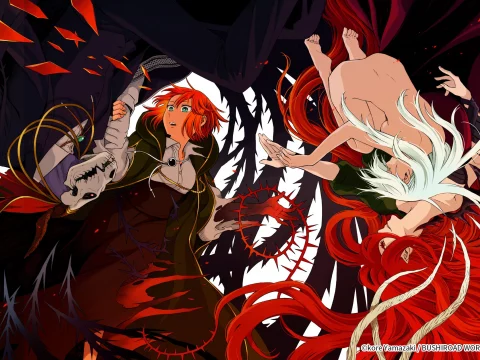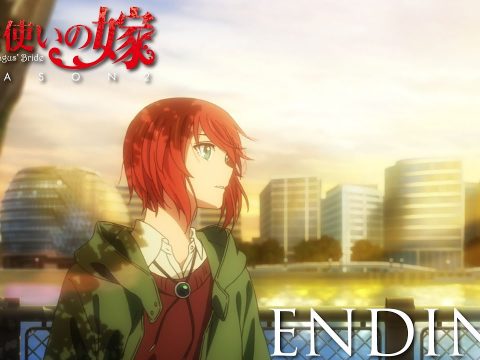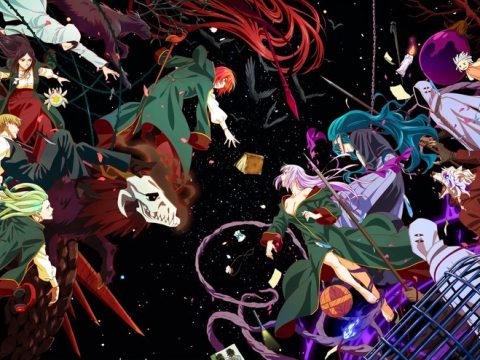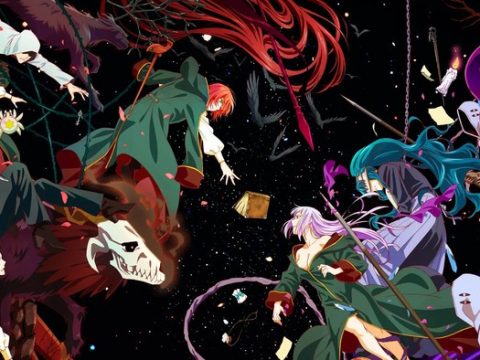The Ancient Magus’ Bride is a fantasy tale that’s less about the fantasy and more about the characters inhabiting the fantasy.

The Ancient Magus’ Bride doesn’t have a very cheery beginning: Chise Hatori, our 15-year-old protagonist, has just allowed herself to be sold off at an underground auction. She’s expected to command a high price because she’s a Sleigh Beggy, a kind of magic user that can draw in and produce enormous quantities of magical energy. The problem is that this causes a massive strain on Chise’s body, and she’s expected to die at a young age because of it. Being a Sleigh Beggy has caused a lot of problems in Chise’s life, ultimately to the point where she considers being auctioned off to the highest bidder the only way to feel a sense of worth. And not too soon after she makes this eyebrow-raising decision, she is bought for a hefty price by the tall and mysterious mage Elias Ainsworth and whisked away to his homely country cottage. Once there, he treats her with a kindness she hasn’t encountered in a very long time—and declares that he will personally tutor her in the ways of magic and, eventually, make her his wife. Did I mention that Elias’s head looks like an animal’s skull?
A lot of us would love nothing more than to spend a good amount of time wandering through an immersive world of magic and fantasy. And among the recent crop of fantasy manga/anime that have emerged over the year, The Ancient Magus’ Bride, adapted from the manga of the same name, stands out from all others. From the very beginning, the anime pulls you in with a unique story about looking for your place in the world and all the trials and errors that come with the journey.

Now, I suspect many of you are reading that synopsis thinking, “Wait a minute, how did this get animated?” Indeed, starting your story with having you character forfeit her own agency and get purchased by a complete stranger, to put it politely, is going to raise a lot of eyebrows, and the relationship between Chise and Elias is bound to raise a whole lot more. And it’s clear from the beginning that Elias is by no means a Hagrid-type of guy. I mean, let’s face it—what other show can you say had a much older being yank on a young girl’s chain and tell her to look forward instead of down? Do you choose to stay enchanted, or do you call child services?
I’m pleased to report, however, that these unusual conventions are not handled in nearly as disastrous a manner as I anticipated. Although the elements of fantasy are front and center in this world, Chise’s experiences are clearly rooted in realistic neglect and depression that the anime fortunately treats with a fine level of sensitivity. After being passed along from home to home that wanted nothing to do with her, she grows up with very little self-worth. So when she meets Elias and finds herself thrown into a completely different world, she finds herself motivated to receive basic acknowledgement from him, and even goes as far as to put her life on the line for others, even if it’s a risk to her health. And even then, the anime is well aware that this characteristic is self-destructive. Ultimately, her growth as a character is a result of finding companionship and support from someone, opening up to the experiences of others, and gaining a sense of belonging.

And then there’s Elias, the infamous Plum Murialis, an unusual combination of man and fae to the point both sides reject him. The fact that he purchased Chise as if she were property is not something the story expects us to forget, as several characters clearly chew him out for doing so. At the same time, however, it’s clear that he never had the intention of actually keeping her as a slave. Literally, once they’re out of the auction house, the first thing he does is remove Chise’s chains, essentially making her a free girl, and it doesn’t look like he’s holding his authority over her in a manipulative way. The problem is that he clearly knows next to nothing about human relationships, be they familial, platonic, or romantic. In fact, I’m not sure he really understands what a wife is. At one point he even admits he can’t comprehend regular human emotions, so part of his development is figuring this sort of thing out. At the end of the day, Elias is simply trying to learn how to be human based on the relationships he’s known with others—he just sucks at it. He’s kind of like a child who uses a racial slur without knowing what it actually means or signifies.
So it’s striking and surprising to see how much Chise and Elias have in common; they’re both outcasts who don’t know how to fit in with the rest of the world, both human and magical. So it does make sense for the two of them to gravitate toward each other like this.
Ultimately, The Ancient Magus’ Bride is less your standard “THE FATE OF THE WORLD IS AT STAKE” tale, and more of an individualistic and explorative character-driven story set in a unique world we get to explore as Chise does. In fact, I’m tempted to compare this show to another anime that’s bursting at the seams with magic—Cardcaptor Sakura. Yes, they look nothing alike on the surface, but both shows have more in common than you think. Neither anime has much villainous activity happening, and most of the time, any magic event that comes from the setting appears to only play second fiddle to the characters. In a way, they’re both character-focused tales that just happen to have magic in them.

Speaking of which, most other fantasy anime we’ve seen so far tend to take their inspiration from JRPGs or tales of the Western variety. The world of Chise and Elias, on the other hand, integrates elements from various mythologies and practices of neopaganism and writes them together in a way that is both cohesive and enticing. There’s a dragon preserve in Iceland, Oberon and Titania rule over the fae that reside in Tír na nÓg, both a selkie and a Slavic water spirit—called a vodyanoi—appear as separate familiars, a brownie (her name is Silky) tends to Elias’s house, and the Wandering Jew, well, wanders the earth. Elias himself even resembles Arawn—the Welsh king of the underworld and leader of the Wild Hunt. There’s even a moment in which different kinds of wood, each with unique properties, are considered for Chise’s wand.
Kore Yamazaki, the author of the original manga, has crafted an extraordinary world, and the anime’s visual execution does a great job in conveying her distinctive vision of magic—something that is rooted in distinct traditions, rather than a power source or a skill meant to be mastered through hard work. There are moments in this show that possess careful animation—such things as coloring, lighting, and shadows—to establish magic as an untamable source of danger. At the same time, however, this feeling of danger actually makes magic feel wonderful to witness and much more impressive to control and contain.

The Ancient Magus’ Bride is by no means a traditional love story. What it is, however, is something that manages to be very “not of this world” while simultaneously being very grounded when it comes to both its pagan research and emotional development. The anime doesn’t hinge on ideas like destiny and adventure so much as it does on the ideas of community, inner strength, and self-fulfillment. You won’t find any Saurons or Buckbeaks around these parts; but you’ll probably see a world so frightening and dazzling you simply can’t look away from it all.
The Ancient Magus’ Bride is available from Crunchyroll and Funimation.
This story appears in the June 2018 issue of Otaku USA Magazine. Click here to get a print copy.





